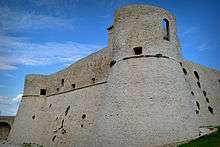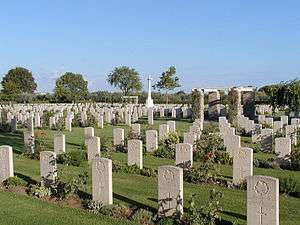Battle of Ortona
| ||||||||||||||||||||||||||||||||
The Battle of Ortona (20–28 December 1943)[1] was a battle fought between a battalion of German Fallschirmjäger (paratroops) from the German 1st Parachute Division under Generalleutnant Richard Heidrich, and assaulting Canadian troops from the Canadian 1st Infantry Division under Major General Chris Vokes. It was the culmination of the fighting on the Adriatic front in Italy during "Bloody December". The battle, known to those who fought it as the "Italian Stalingrad"[6] for the deadliness of its close-quarters combat, took place in the small Adriatic Sea town of Ortona, with its peacetime population of 10,000.
Background
The British Eighth Army's offensive on the Winter Line defences east of the Apennine mountains had commenced on 23 November with the crossing of the river Sangro. By the end of the month, the main Gustav Line defences had been penetrated and the Allied troops were fighting their way forward to the next river, the Moro, 4 miles (6.4 km) north of the mouth of which lay Ortona. For the Moro crossing in early December the exhausted British 78th Infantry Division on the Allied right flank on the Adriatic coast had been relieved by the Canadian 1st Infantry Division, under Major-General Christopher Vokes.[7] By mid-December, after fierce fighting in the cold and mud, the Division's 1st Infantry Brigade had fought its way to within 2 mi (3.2 km) of Ortona and was relieved by the 2nd Infantry Brigade for the advance on the town.
Ortona was of high strategic importance, as it was one of Italy's few usable deep water ports on the east coast, and was needed for docking allied ships and so shorten Eighth Army's lines of supply which at the time stretched back to Bari and Taranto. Allied forces were ordered to maintain the offensive, and going through the built up areas in and around Ortona was the only feasible option. Ortona was part of the Winter Line defence system and the Germans had constructed a series of skilfully designed interlocking defensive positions in the town. This—together with the fact that the Germans had been ordered to "fight for every last house and tree"—[8][9] made the town a formidable obstacle to any attacking force.
Battle


The Canadians faced elements of the renowned German 1st Parachute Division. These soldiers were battle-hardened after many years of war, and were ordered by Adolf Hitler to defend Ortona at any cost.
The initial Canadian attack on the town was made on 20 December by Canadian 2nd Brigade's Loyal Edmonton Regiment with elements of the Seaforth Highlanders of Canada under command.[9] Meanwhile, elements of the division's 3rd Infantry Brigade launched a northerly attack to the west of the town in attempt to outflank and cut off the town's rear communications but made slow progress because of the difficult terrain and the skillful and determined German defence.
The Germans also concealed various machine guns and anti-tank emplacements throughout the town, making movement by armour and infantry increasingly difficult.[10] The house to house fighting was vicious and the Canadians made use of a new tactic: "mouse-holing". This tactic involved using weapons such as the PIAT (or even cumbersome anti-tank guns) to breach the walls of a building, as houses within Ortona shared adjoining walls.[10] The soldiers would then throw in grenades and assault through the mouse holes, clearing the top floors and making their way down, where both adversaries struggled in repeated close-quarters combat.[9] Mouse-holing was also used to pierce through walls into adjoining rooms, sometimes catching enemy troops by surprise. The tactic would be used repeatedly as assaulting through the streets inflicted heavy casualties on both Canadian and German troops. Later, in a particularly deadly incident, German Fallschirmjäger engineer Karl Bayerlein demolished an entire house packed with Canadian soldiers; only one soldier survived.[11] After six days of combat, 2nd Brigade's third battalion, Princess Patricia's Canadian Light Infantry, joined the battle together with tanks from 1st Canadian Armoured Brigade's Three Rivers Regiment.
On 28 December, after eight days of fighting, the depleted German troops—who lacked reinforcements—finally withdrew from the town. The Canadians suffered 1,375 dead[3] during the Moro River battles of which Ortona was a part. This represented almost a quarter of all Canadians killed during the entire Italian Campaign.
Images
-

Infantrymen of the Loyal Edmonton Regiment advance with Sherman tanks of the Three Rivers Regiment
-

Canadian rifleman, December 1943, Ortona, Italy.
-

German corporal killed during fighting against the Loyal Edmonton Regiment, Ortona, Italy.
-

Ortona War Cemetery, This cemetery contains 1,615 burials; 52 are unidentified by name. Number of graves: Canada 1,375, United Kingdom 169, New Zealand 42, South Africa 16, India 5, Australia 4, Other Allied 2. Entirely unidentified 2.
See also
Notes
Footnotes
- ↑ Mainly Canadian. Includes losses to the Loyal Edmonton Regiment of 172 casualties, of which 63 killed; the Seaforth Highlanders 103, of which 41 killed.[2] Sources are often confused between figures for the eight days of fighting at Ortona and those for the whole of the December campaign. Zuehlke gives Canadian losses for this period of 1375 dead and 964 wounded[3] while the Canadiansoldiers.com website says casualties for Canadian 1st Infantry Division in December (including 1st Brigade's crossing of the Moro, 2nd Brigade's fighting in the town and 3rd Brigade's attempted outflanking attack) totaled 4,206 including 695 killed.[4]
Citations
- 1 2 Canada at War website: Battle of Ortona
- ↑ Landry, Pierre (2003). Beauregard, Marc, ed. "Juno Beach Center: The Capture of Ortona". Archived from the original on 27 September 2007. Retrieved 2007-09-27.
- 1 2 Zuehlke (1999),
- ↑ "Canadiansoldiers.com: Ortona". Archived from the original on 2007-09-26. Retrieved 2007-09-27.
- ↑ Fabio Toncelli. Sd Cinematografica, ed. "ORTONA 1943: UN NATALE DI SANGUE, Page 10." (PDF). Retrieved 2015-08-31.
- 1 2 Zuehlke (1999),
- ↑ Zuehlke (1999), p. 14
- ↑ Farley Mowat, And No Birds Sang.
- 1 2 3 Zuehlke (1999), p. 160
- 1 2 Bercuson, p. 175
- ↑ Zuehlke (1999), p. 343
Sources
- Bercuson, David (2001) [1996]. Maple Leaf Against the Axis. Red Deer Press. ISBN 0-88995-305-8. OCLC 55973783.
- Mowat, Farley (1979). And No Birds Sang. McClelland & Stewart. p. 219 pages. ISBN 978-0-7710-6618-4.
- Zuehlke, Mark (1999). Ortona: Canada's epic World War II battle. Vancouver: Douglas & McIntyre. ISBN 1-55054-557-4.
External links
| Wikimedia Commons has media related to Battle of Ortona. |
- http://www.ortonaamare.it/1943.html
- Remembering Ortona - 65th Anniversary - Dead
- Ortona and the Italian Campaign - 65th Anniversary
- The Battle of Ortona (The "Italian Stalingrad") - Complete overview, video / audio and a large picture gallery.
- CdnMilitary.ca Battle of Ortona website for Veterans Week 2004
- CBC history on the Battle of Ortona
- Canadian Encyclopedia Entry
- How the Enemy Defended the Town of Ortona (U.S. intelligence report)
- Juno Beach center: Ortona
- canadiansoldiers.com article on Ortona
Coordinates: 42°21′00″N 14°24′00″E / 42.3500°N 14.4000°E
